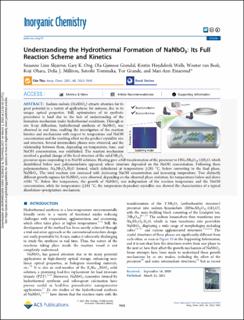| dc.description.abstract | Sodium niobate (NaNbO3) attracts attention for its great potential in a variety of applications, for instance, due to its unique optical properties. Still, optimization of its synthetic procedures is hard due to the lack of understanding of the formation mechanism under hydrothermal conditions. Through in situ X-ray diffraction, hydrothermal synthesis of NaNbO3 was observed in real time, enabling the investigation of the reaction kinetics and mechanisms with respect to temperature and NaOH concentration and the resulting effect on the product crystallite size and structure. Several intermediate phases were observed, and the relationship between them, depending on temperature, time, and NaOH concentration, was established. The reaction mechanism involved a gradual change of the local structure of the solid Nb2O5 precursor upon suspending it in NaOH solutions. Heating gave a full transformation of the precursor to HNa7Nb6O19·15H2O, which destabilized before new polyoxoniobates appeared, whose structure depended on the NaOH concentration. Following these polyoxoniobates, Na2Nb2O6·H2O formed, which dehydrated at temperatures ≥285 °C, before converting to the final phase, NaNbO3. The total reaction rate increased with decreasing NaOH concentration and increasing temperature. Two distinctly different growth regimes for NaNbO3 were observed, depending on the observed phase evolution, for temperatures below and above ≈285 °C. Below this temperature, the growth of NaNbO3 was independent of the reaction temperature and the NaOH concentration, while for temperatures ≥285 °C, the temperature-dependent crystallite size showed the characteristics of a typical dissolution–precipitation mechanism. | en_US |

